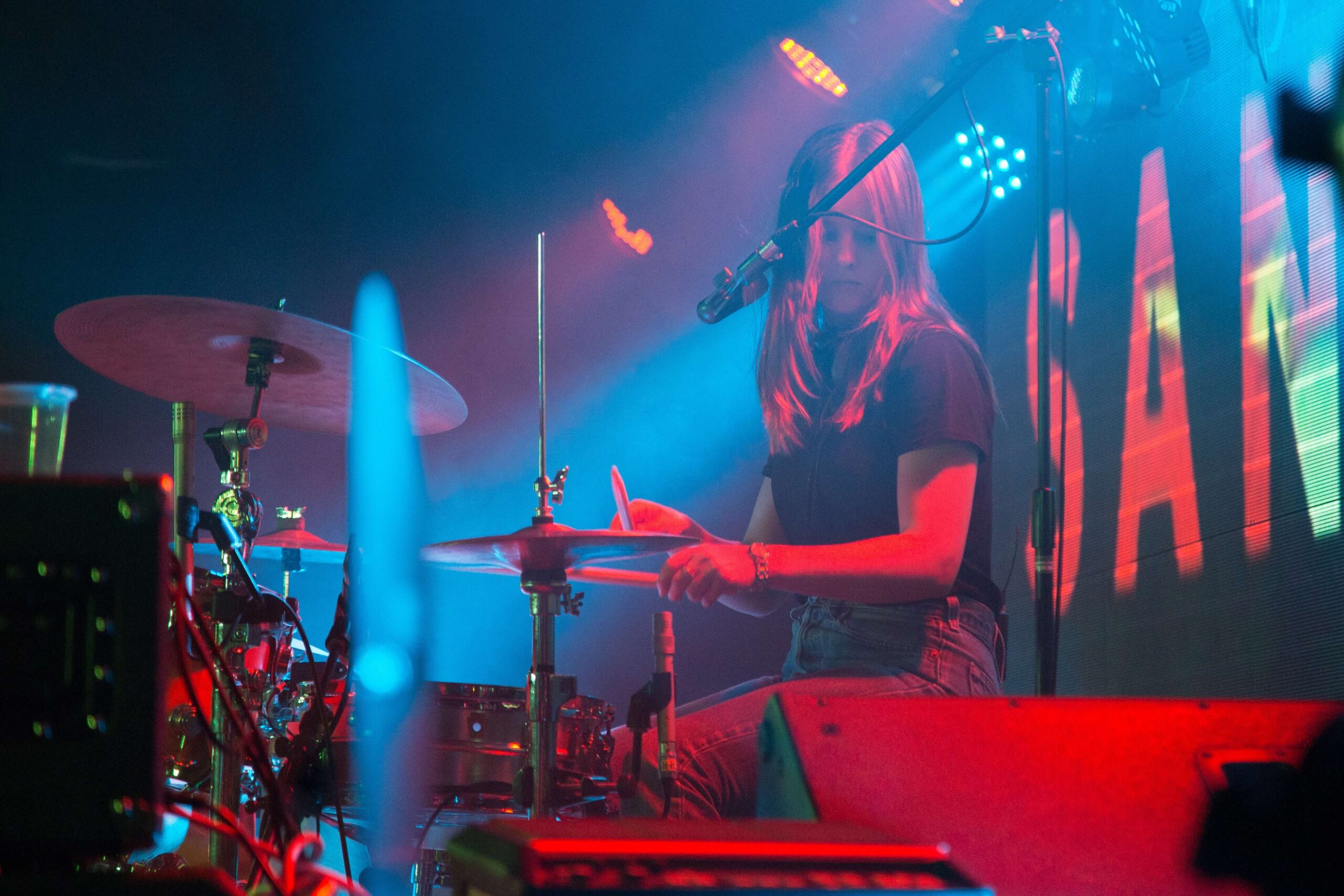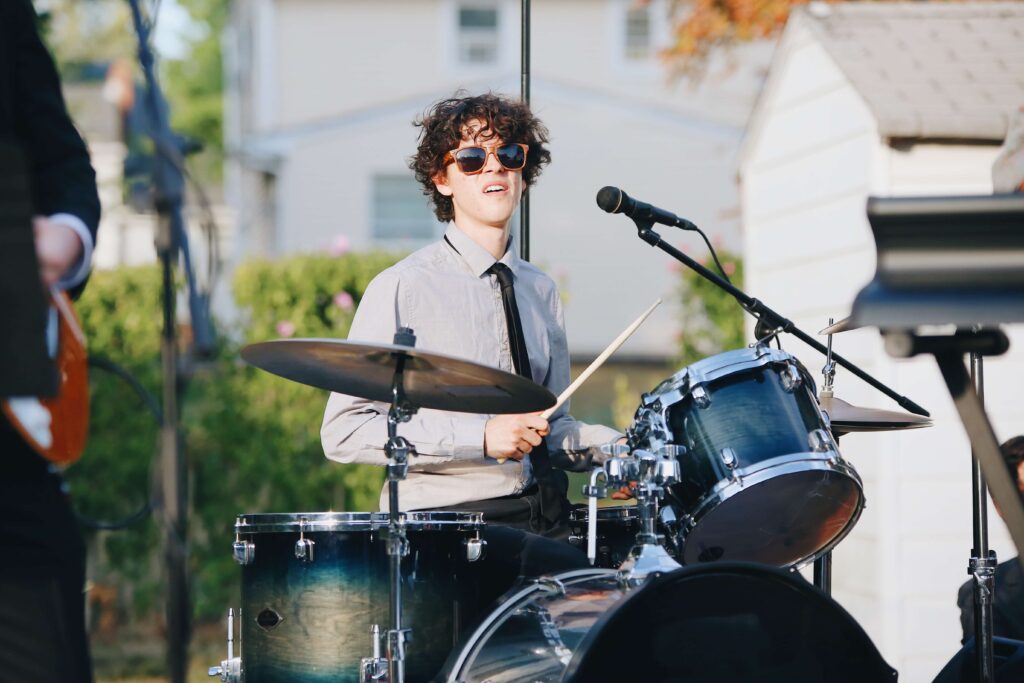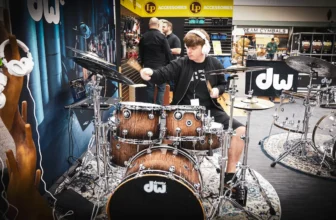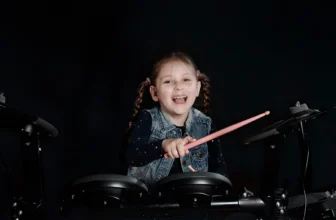Best Vocal Mic For Drummers and Tips for Perfect Sound


Adding a vocal microphone to your drum setup can really enhance your live performance with your band. You’ll be able to add extra harmonies, sing main parts, and even interact with the crowd when you’re other band members are busy tuning up or off-stage.
Certain microphone stands can be very annoying and it can be hard to find the right microphone that works for you.
We have highlighted our two favorite vocal mics in blue and green. Most drummers opt not to sing, but for those who do, like Carter Beauford and Mike Portnoy, singing can be another added element to your band’s live show.
Should I use a stand-mounted vocal microphone?
If you have an old SM58 lying around, you can grab a boom stand and start singing immediately. However, you will potentially have an issue with the stand getting in the way of your playing. If you opt for a headset microphone, you won’t necessarily have this issue.

Use a stand-mounted microphone if you use it occasionally
If you only sing on certain songs, I would opt for the stand-mounted microphone. You can spin the microphone around and essentially “put it away” for the songs you don’t sing on.
The Shure SM58S is a great choice for singing drummers on a budget

If you have to spend as little as possible, using a stand with an SM58S is going to be the most cost effective way. There’s a switch on the side of the microphone that allows you to turn it off when you’re not singing—improving the mix for the engineer at front of house. There will be less bleed on songs when you’re not singing, so that will help them greatly.
Headset microphones are expensive because you will need to have a wireless pack and a receiver. Be sure to buy the Shure SM58 that includes the on-off switch. It will reduce stage volume to front of house and reduce the chance of feedback.
Use a gooseneck attachment
If you want to free up the playing space in front of you, a good way to do that is to use a goose neck microphone attachment. In this scenario, the microphone stand will actually sit behind you and the microphone will come up and over your head.
Use the goose neck attachment to bend the microphone down to in front of your face. Just be careful to not go cross eyed while playing. Even in this setup, singing while playing can be a little cumbersome.
Why the switch variant?
While Shure does make a version of the 58 without a switch, as a drummer, it may be beneficial to have the switch on your microphone. If you aren’t the lead singer in the band, chances are there are tunes you won’t sing on.
For these songs, turn the switch off to reduce bleed to the PA. This is especially helpful if you don’t have a dedicated sound engineer.
Using a headset microphone while playing drums live
If you opt for the more expensive solution, you’ll be much more free while playing your drums. Singing is far easier with this setup as you’ll be able to move your head freely around as you please.
Feedback can be an issue with any microphone, but since you are playing drums, it can be very difficult to get right. Many of the microphones we show on this list offer what is called feedback suppression.
If you use in-ear monitors (I highly suggest this), feedback will be no problem. Your vocal mix in your ears will be tough to nail, but it is the optimal solution for a vocal mic for drummers.
Headset vocal microphones do not allow for dynamic singing
Imagine a singer hitting a really high and very loud note. Do you see them backing away from the microphone? I do.
With a headset microphone, this is no longer possible and dynamic singing is nearly impossible. This will require you and your front of house engineer to use a lot of compression on your voice.
Many people who have tried headset vocal microphones do not like them. However, there will always be outliers in anything in the world.
Reality check: heavy hitters beware
If you play hard and really make your drums sing, having a vocal microphone is going to be difficult. If you in ear monitors, you’re going to hear a lot of bleed from your kit on this channel and you’re going to have to leave the monitor level of your vocals down significantly.
If you’re still rocking wedge monitors, you might be alright for hearing your mix, but feedback can sure be a major issue, so be sure to look out.
It’s hard enough to get drum bleed out of a vocalist’s monitor mix, let alone a drummers. The Shure Beta 56A is a solid choice for drummers looking for the most isolation in their monitor mix.





Hi — I know this article is a year old, but I just came across it and had to comment. I’m a heavy hitter and have been described as a “very animated” drummer. When I started singing and drumming a few years ago, I tried every conceivable mic position and microphone out there, and had a horrible time finding any combination that didn’t feed back, get hit by my flailing sticks, or fall over in the middle of a song. All of my problems were solved with a Shure Beta 56A. The boom on a Tama Iron Works Studio mic stand runs a few inches over my head, and a 13″ Proline gooseneck drops the mic in front of my face. The short 56A body is well out of the way of my sticks, and by leaving the top clutch loose on the mic stand, I can easily swivel the mic in or out of the way, even while playing. They solid iron legs on the stand keep it upright at all times; it has never tipped on me.
Regarding the 56A itself — AMAZING!!! I’ve heard that it has the same guts as the Beta 58A, but I can’t confirm it. Either way, its dynamic range is on par with the 58A, and it sounds just as good to my ears, recorded and live. Even better, the supercardioid pickup pattern does exactly what Shure claims, and it only picks up what is directly in front of the grille. I’ve run wedge and main-size monitors on the floor behind me, multiple shows and venues, big sticks & hard hits — it has never fed back. I’ve also recorded vocals with it, while playing my acoustic drums, in a non-muffled room. All you can hear on my track are the vocals. If you crank the volume with a good set of headphones, you can hear my snare and hi-hat, but they sound like faint reverb echo.
Added bonus: It’s made to make your drums sound great, so you can mic your drums with it when you’re not singing.
Hope this helps someone!
Otis! Thanks so much for the insightful comment!
I lead virtual drum circles on my 36″ Mother Drum, like a pow-wow drum and often sing while drumming or speak before and after…. sometimes inside in my living room, sometimes outside in a natural area (mountains). I’m looking for an affordable (under $100) clip-on wireless microphone which will do the deep sound of the drum some justice. Any suggestions, please ?
Thanks Nic… great advice…!